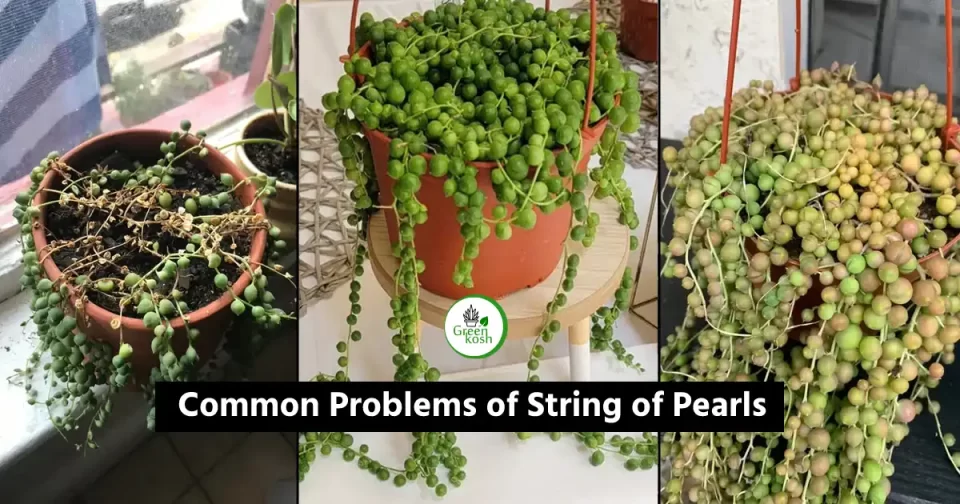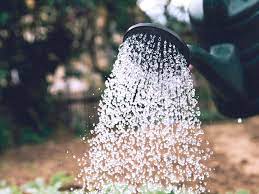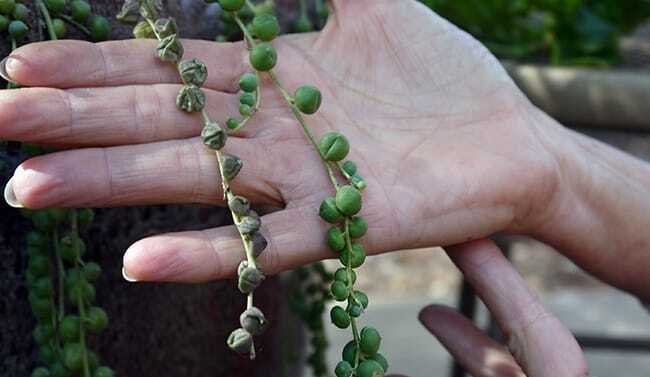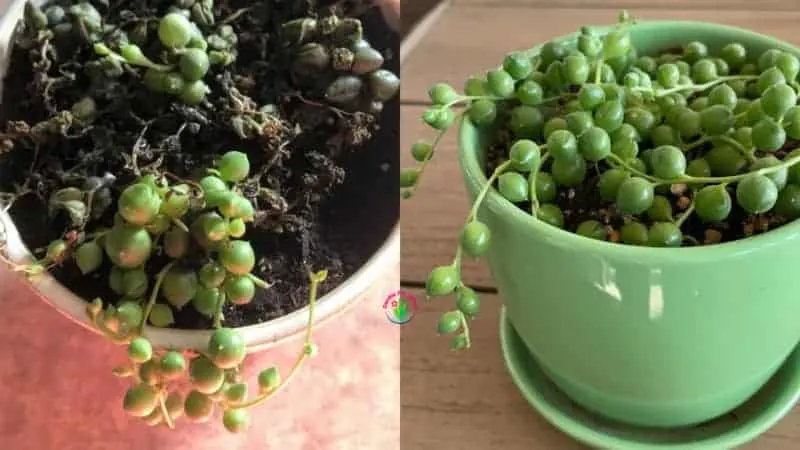“String of Pearls”, also known as Senecio Rowleyanus, is a popular trailing plant that is known for its small, round leaves that resemble pearls. However, despite its hardy nature and easy-care requirements, String of Pearls is prone to certain problems that can affect its growth and appearance.

In this article, we will discuss some common String of Pearls problems and how to recognize and solve them.
1. Overwatering

One of the most common problems with String of Pearls is overwatering. String of Pearls is susceptible to root rot if it is overwatered. If the leaves on your String of Pearls are turning yellow, it could be a sign of overwatering.
To solve this problem, make sure you are watering your String of Pearls only when the soil is dry to the touch and make sure it is planted in well-draining soil.
2. Lack of Light
Another common problem with String of Pearls is a lack of light. String of Pearls prefers bright, indirect light. If it is not getting enough light, the leaves will become elongated and lose their compact appearance.

To solve this problem, make sure you are placing your String of Pearls in a location that receives bright, indirect light.
3. Pests on String of Pearls
Pests are also a common problem for String of Pearls plants. The most common pests that can affect String of Pearls include spider mites and mealybugs. Spider mites are tiny, red or black spider-like creatures that feed on the sap of the plant. They can cause yellow stippling on the leaves, and in severe cases, can cause the leaves to dry out and drop off.

To control spider mites, you can spray the plant with a mixture of water and dish soap, or use an insecticidal soap. Mealybugs are small, white, cottony insects that feed on the sap of the plant.
They can cause the leaves to turn yellow and can also produce a sticky honeydew substance that can attract ants. To control mealybugs, you can wipe them off with a cotton swab dipped in rubbing alcohol, or use an insecticidal soap.
4. Propagating String of Pearls

Finally, it’s important to note that String of Pearls can be difficult to propagate as the leaves are very small, and the offsets (baby plants) can be hard to detect. The best way to propagate them is to take stem cuttings, let them callus over for a few days and then plant them in well-draining soil.
5. Soil and Pot Size
Soil that is too wet can be a problem for String of Pearls plants. This is because String of Pearls are susceptible to root rot if they are overwatered. Overwatering can occur if the soil is too dense or if the pot size is too large. When the soil is too dense, it doesn’t allow for proper drainage and the water can become trapped in the soil, leading to root rot. Additionally, if the pot size is too large, the soil will retain more moisture than the plant can use, leading to the same problem.

To solve this problem, it’s important to ensure that the soil is well-draining and that the pot size is appropriate for the plant. You can do this by mixing perlite or coarse sand into the soil, or by using a cactus or succulent potting mix. Additionally, you should make sure that the pot has drainage holes at the bottom to allow excess water to escape. It’s also important to make sure that the pot size is appropriate for the plant, using a pot that is only slightly larger than the root ball.
It’s also important to keep an eye on the soil moisture, watering only when the soil is dry to the touch. A good way to check the soil moisture is to stick your finger in the soil or use a moisture meter.
It’s important to keep in mind that String of Pearls are drought-tolerant and they don’t require frequent watering. In fact, they can survive in low-light conditions. So, it’s best to err on the side of caution and not to over water them.
Conclusion, String of Pearls is a hardy and easy-care plant, but it’s important to keep an eye on the plant and address any issues as soon as they arise to keep the String of Pearls healthy and happy. With the right care, your String of Pearls will thrive and bring beauty to your home.
How do you save a dying string of pearls?

Saving a dying String of Pearls plant can be a bit challenging, but with the right care and attention, it may be possible to revive it. Here are some tips on how to save a dying String of Pearls:
- Check for pests: One of the most common causes of a dying String of Pearls is pests. Check the plant for signs of spider mites or mealybugs. If you find any, treat the plant with an insecticidal soap or wipe the pests off with a cotton swab dipped in rubbing alcohol.
- Check for root rot: Another common cause of a dying String of Pearls is root rot. To check for root rot, take the plant out of its pot and examine the roots. If they are brown and mushy, they have root rot. Remove the affected roots and repot the plant in fresh, well-draining soil.
- Provide proper light: String of Pearls prefers bright, indirect light. If your plant is not getting enough light, the leaves will become elongated and lose their compact appearance. Move the plant to a location where it will receive bright, indirect light.
- Water properly: String of Pearls is susceptible to root rot if it is overwatered. Water your plant only when the soil is dry to the touch. Use a moisture meter to check the soil moisture or stick your finger in the soil, this will help you to know when it’s time to water.
- Trim the plant: If the plant is dying from the bottom up, trim off the dead leaves and stems. This will help to promote new growth.
- Be patient: String of Pearls are slow-growing plants, so it may take some time for the plant to recover. Be patient and continue to provide proper care and attention.
FAQs
Q1: Why are the leaves on my String of Pearls turning yellow?
The leaves on a String of Pearls can turn yellow due to a lack of light or overwatering.
Q2: How do I control spider mites on my String of Pearls?
To control spider mites, you can spray the plant with a mixture of water and dish soap, or use an insecticidal soap.
Q: Why are there small, cottony insects on my String of Pearls?
The small, cottony insects are most likely mealybugs, which are a common pest for String of Pearls plants.
Q4: How do I propagate String of Pearls plants?
String of Pearls can be difficult to propagate as the leaves are very small, and the offsets (baby plants) can be hard to detect. The best way to propagate them is to take stem cuttings, let them callus over for a few days and then plant them in well-draining soil.
